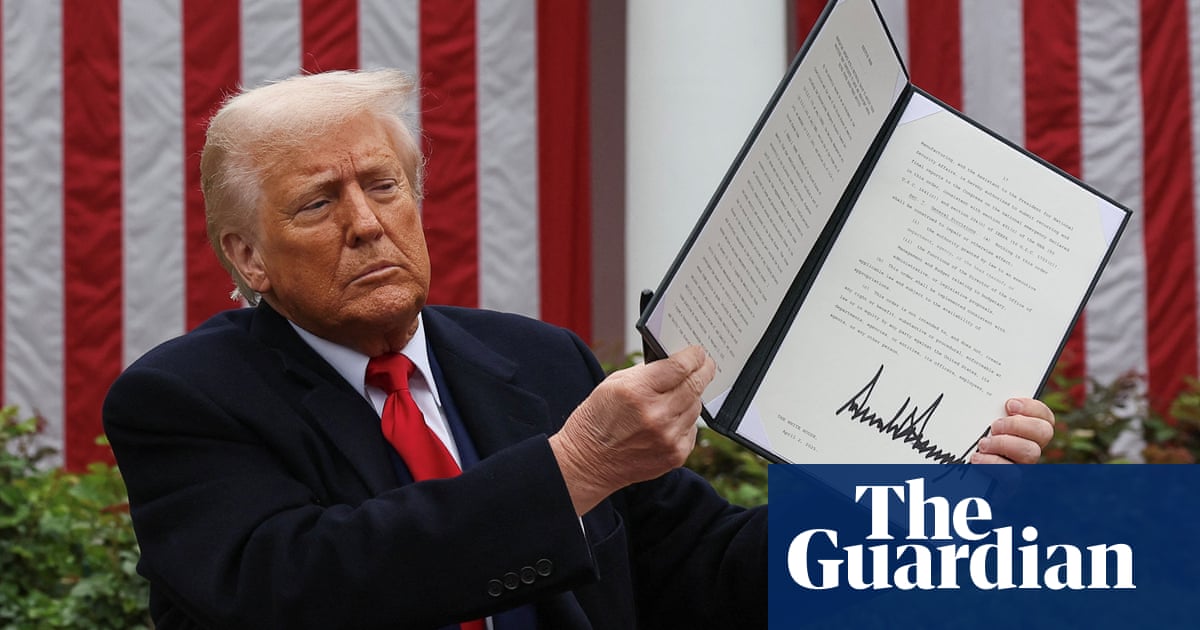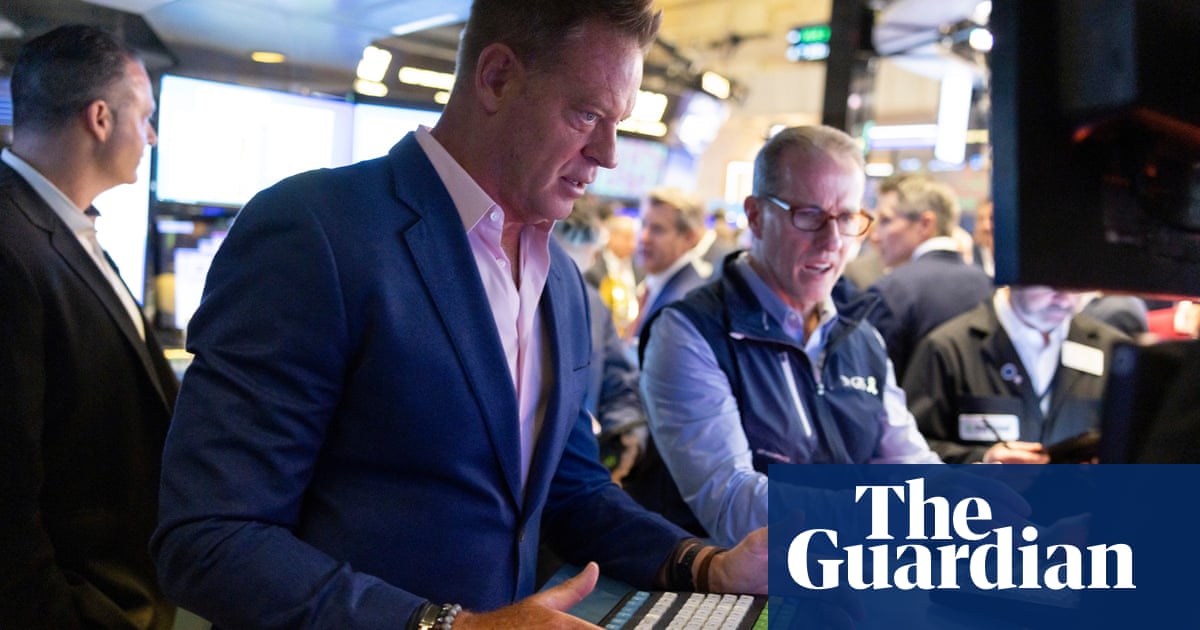Liberation days signal the end of a war, not the start of one.
So it is with rich irony that the US president, Donald Trump, has declared victory even as he massively escalates his attack on the global trading system.
As Trump attempted to recast the world’s richest nation as a victim of “perfidious” foreigners who have been taking advantage of the superpower for too long, he unveiled sweeping 10% tariffs on goods imported from Australia. Notably, pharmaceuticals – one of Australia’s top exports to the US – escaped tariffs, as did critical minerals that are not mined in the US.
The treasurer, Jim Chalmers, nevertheless declared it “a dark day in the global economy” as he promised to release updated Treasury modelling of how bad the tariffs will be for Australia.
“These escalating trade tensions, these tariffs announced by the Trump administration in Washington DC, are self-defeating, they are self-sabotaging,” Chalmers said.
What impact will the tariffs have on Australia?
The US only buys about 5% of what Australian businesses sell overseas, but economists say the entire world, and especially trade-exposed nations like Australia, would lose from America raising its protectionist walls to the highest levels since 1909.
The chief economist at KPMG, Brendan Rynne, estimates that the average tax rate on US imports is set to soar by more than 18 percentage points.
In Rynne’s model, the world economy as a result would shrink by about 0.4%.
And as a country that has depended on trade to drive prosperity, he estimates the new tariffs will deliver a $27bn blow to Australia’s economy, or as much as 1% of GDP.
With tariffs on US imports from China – our largest trading partner – jumping over 50%, even that estimate may prove too optimistic, he says.
“We’re a medium-sized, open economy that is dependent on world trade for our economic prosperity. In essence this is shaking up world trade, and how this all plays out will be difficult to say.”
Australian consumers could also face a brief lift in prices.
“We get an inflation pulse of about 1%, but it comes and goes very quickly,” Rynne says.
Experts agree that the prognosis for America’s economy and its consumers is potentially much more severe.
But with Trump having signalled he plans to use higher tariff revenue to pay for big tax cuts, it’s an open question whether his trade aggression will hurt the president’s popularity at home and his determination to use tariff policy as a tool to “make America great again”.
“We are in a big experiment where we are judging rhetoric against logic – and we will find out soon enough which one’s the winner,” Rynne says.
What happens if other countries retaliate?
Soon after the announcement in the White House Rose Garden, the US treasury secretary, Scott Bessent, warned other nations against hitting back with tariffs of their own.
“This is the high end of the number barring retaliation. As far as negotiations go – we’ll see,” Bessent told Bloomberg.
Australia has escaped relatively lightly with no additional “reciprocal” levies, as other putative allies have been treated substantially worse.
Japan and the EU were hit with across-the-board imposts of 20% and 24%, respectively.
Meanwhile, taxes on Chinese imports will rise by 34 percentage points to 54% in the latest announcement, according to Bloomberg. China has since vowed to respond in an unspecified way.
after newsletter promotion
What this means for China – which buys the lion’s share of Australia’s total exports – matters hugely for how the Australian economy weathers this storm.
While Treasury officials have estimated a relatively minor hit to growth at home from higher US tariffs, they have emphasised that the indirect hit to the economy from the knock-on effects of a possible global trade war could be far higher.
The chief economist of AMP, Shane Oliver, says his initial calculation is that US levies as a percentage of its total imports would jump from under 5% to nearly 25%.
Oliver estimates the risk of a US recession is now 40%, and that global growth would drop from 3% towards 2% “depending on how significant retaliation is and how countries like China respond with policy stimulus”.
Preliminary modelling by another economist, who spoke to Guardian Australia but was unwilling to go on the record, showed the US slumping into recession for the rest of 2025 as inflation shot higher and consumer spending collapsed.
Countries around the world are grappling with how to respond to Trump, cobbling together policies mixed with diplomacy and flattery to reduce the likelihood of becoming a target.
Some, including China, have devised retaliatory packages to demonstrate they are capable of causing the US pain, while others are seeking to give concessions that are domestically palatable.
Wesley Widmaier, a professor of international relations at the Australian National University, says Australia has historically been successful in playing the long game.
“Australia can keep the powder dry and play the transactional game that it’s always been very smart in playing by letting other countries kick up more dust,” Widmaier says.
What is Trump’s beef with Aussie beef?
Trump in his opening speech suggested that Australian beef would be banned, but this proved to be a rhetorical flourish and the 10% levy will apply to our largest export to the US.
Australia accounts for about a quarter of US beef imports, and the additional levy comes at a time when American beef buyers have become increasingly reliant on overseas sellers.
Thanks to drought, American cattle numbers have dropped to multi-decade lows, and local producers can’t keep up with a rise in demand. No surprise, then, that Australian imports have reached record levels in 2025 – up 30% so far compared with last year. Prices are 16% higher than a year earlier.
It appears that Canadian and Mexican exporters have escaped additional levies, but still face higher tariffs under a previous round. And America’s need for imported beef will probably only rise this year as US farmers rebuild their stock numbers.
Dennis Voznesenski, an agricultural economist at CBA, says these factors suggest beef prices would hold up through 2025 and American buyers will bear the burden of higher taxes on imported meat.
“While the tariffs are unquestionably a negative (for Australian producers), the constrained state of US cattle availability and possible herd rebuild will mean that the tariff burden will likely be spread between both exporters and the US until the US can rebalance its domestic cattle supply,” Voznesenski says.










